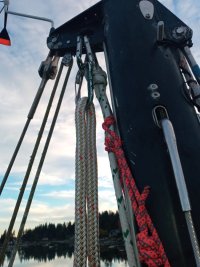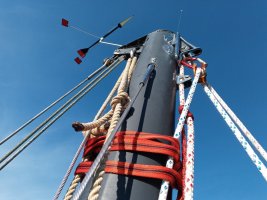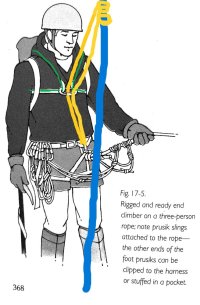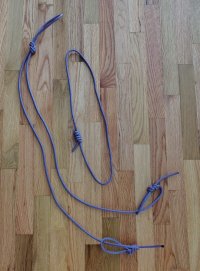@Vtonian: You seem to have at least a fair knowledge of rope climbing. I’ve had few hours of mountaineering training, and maybe a dozen mast climbs without incident. So, it’s bothered me that our views about descending with prusiks were opposed 180 degrees. I took a look at some of the “Nice Guy Dave, at Wespur” videos you recommended, hoping they’d shed some light on our differences. They did.
TLDR: The Nice Guy Dave (a professional arborist) videos, in addition to your comments;
‘Prusiks are fine for going up, not coming down….. controlled friction…. use for descent may be subject them to intense heat…. [having] a prusik tie-in get away from you,’
all lead me to assume you are referring to the use of prusiks as a
RUNNING-type friction hitch.
Conversely, the method I'm referring to (the Texas Prusik/Crevasse Rescue method,
TP/CR for short) uses two
STATIC-type friction hitches, which never allow the climbing rope to “run” through the hitch.
With that clarified, I’m guessing we'd both agree that:
- A STATIC-type friction hitch should not be used in a RUNNING-rope climbing system (for either ascending or descending).
- Since the STATIC-type friction hitches used in the TP/CR method are used in exactly the same manner whether a climber is ascending or descending, they are equally suited to either use.
The full story:
During a recent, long hotel stay, I watched two videos from Nice Guy Dave, and two from other arborists. The first thing that struck me was that Dave was wearing a $500 climbing harness (Petzl Sequoia) with about $2k in fancy climbing gadgets attached to it. He earns a living with that equipment and spends 30 hours a week in a tree, so I get it. He’ll also be happy to sell you that equipment at
https://www.wesspur.com/ (the arborist’s REI?).
The second thing I noticed, in both Dave’s and the other’s videos, was that every time an arborist talked about hooking their “prusik” onto their climbing line, they pulled out a device that recreational climbers would typically call an “autoblock.” In all cases I watched, they used a separate (and sometimes, multiple) device(s) to facilitate the actual ascending/descending of the rope. The “prusik” or “autoblock” was only used as a backup device. As such, while they climbed or descended the rope, they “tended” the “prusik/autoblock” hitch so the climbing rope could freely “
RUN” through it (tending” the hitch typically means “pushing” on its coiled wraps to prevent them from tightening around the climbing rope). The idea is, in the case of emergency or incapacitation, once the “prusik/autoblock” ceases to be tended, it bites into the climbing rope and becomes a “
STATIC,” immovable safety hitch around the climbing rope (a position hold).
 <Autoblock with Machard knot
<Autoblock with Machard knot 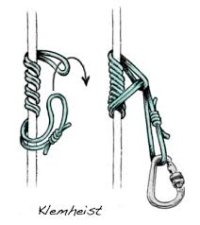 <with a Klemheist
<with a Klemheist
Autoblock, tied with a Machard knot. If one loop of the Machard is put through the other loop on its way to the carabiner, it may be called a Klemheist. But names vary. A Machard knot is often called a French Prusik. And, Prusik seems to be used, generically, to refer to almost any kind of wrapped-rope hitch used for rope climbing.
In stark contrast to Dave, I’m a weekend-warrior mast climber. I’ll spend maybe 30 hours hanging from my prusiks, wrapped around my boat’s halyards, over the course of my lifetime. If $2k in equipment were the mast-climbing entry point, I’d be better-off paying someone else to go aloft. I just want to do it safely, with a minimal need for new gear. I use the Texas Prusik/Crevasse Rescue (
TP/CR for short) method when I go aloft. When I learned TP/CR in a mountaineering class, they used the name “Prusik Hitch” to specifically refer to a double- or triple-wrapped version of the Cow Hitch.
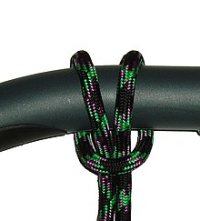
Cow Hitch
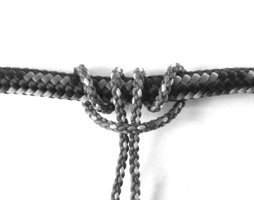
(doubled)
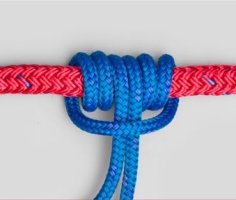
Prusik (tripled)
But, the term “prusik” was also used to refer the rope loop used to make the hitch (the prusik loop), and the process of using the loops to climb the rope (prusiking up/down the rope).
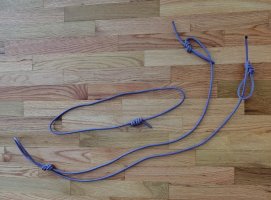 Prusik Loops for waist and foot attachment. Apparently, the term "Texas Prusik" refers specifically to a prusiking system with dual, rather than single, foot loops.
Prusik Loops for waist and foot attachment. Apparently, the term "Texas Prusik" refers specifically to a prusiking system with dual, rather than single, foot loops.
In the TP/CR system, two prusik loops are used: one between the climbing rope and your waist harness, and the second between the climbing rope and your feet. To start, the waist(*) prusik is
slid (while loosened and unweighted) up the climbing rope as far as it will reach. Then the prusik knot is
dressed (the coils arranged neatly),
set (given a light tug to start it biting into the climbing rope), and finally,
weighted (by lifting your feet to let the waist prusik support your full body-weight). The single waist-prusik knot is now set,
statically, around the climbing rope (as a position hold), and fully supporting your weight. Next, the climber raises his feet/knees towards his chest to de-weight the foot-loop prusik. Once de-weighted, the
slide-dress-set-weight ritual is repeated with the foot-loop prusik. Once the foot prusik knot is statically set, the climber stands up in the foot-loops, which then support his full body weight (and, thus, de-weights the waist prusik). By repeating the
slide-dress-set-weight ritual, one knot at a time, the climber inchworms (actually, it’s about an 18” move) his/her way up/down the rope. Obviously, it works exactly the same whether climbing or descending.
The important differences from the arborist’s autoblock are that (a) the prusik hitches are, in themselves, the primary climbing device, and (b) the climbing rope is never allowed to “RUN” freely through the prusik hitches. In TP/CR, the prusik knot is weighted only after it is statically locked onto the climbing rope, and moved (slid) only when it is unweighted. And, since there are always two prussik hitches around the climbing rope, there is a bit of a built-in safety. Even if one knot were to inadvertently slip, that slip is arrested when either, 1) the slipped knot hits the second knot, or 2) the two knots get pulled out to the maximum extension of their loops
I don't think you'll hear many arborists talking up the TP/CR method—it’s way too cumbersome for someone who earns a living working in trees. And, consider that, for safety, a mast-climber hopefully performs the
slide-dress-set-weight ritual, sequentially, on two additional safety lines while moving about aloft. It takes me about 20 minutes to climb my mast and about 15 minutes to get back down. An arborist (who could be working up at three times the 45’ height of my mast) can’t spare 45 minutes to downclimb. Considering he’s likely got 3 other workers waiting idle at the bottom, that would be three man-hours of lost work. He wants to zip down in a rappel-like style with an
adjustable-friction, running-rope descent system in two minutes or less. But not me. I plan for jobs to perform on the way down—re-tape the spreader boots, caulk the fore-deck light, clean the mast track, add hardware, Tef-Gel some fasteners, etc. I’ve never seen the need to zip down the mast in SWAT-team like fashion. It does look cool though.
Hope this helps clear things up for anyone who might be considering a mast climb. And, please weigh-in with comments, corrections, or tips.
*Note: I call it the “waist” prusik because the lower end hooks to the carabiner on your climber’s waist-harness. However, as the prusik-loop rises from the waist harness, it should pass through a carabiner on your chest-harness before reaching the climbing rope. This chest-harness connection keeps your torso upright in the event of a fall. A chest harness can be made from a simple loop of climber’s webbing, crossed in an X across your back (the X can just be a twist, it doesn't need to be "tied"), one loop-end around each shoulder, and joined in the center with a carabiner. An example:
http://www.chockstone.org/techtips/Chest.htm
